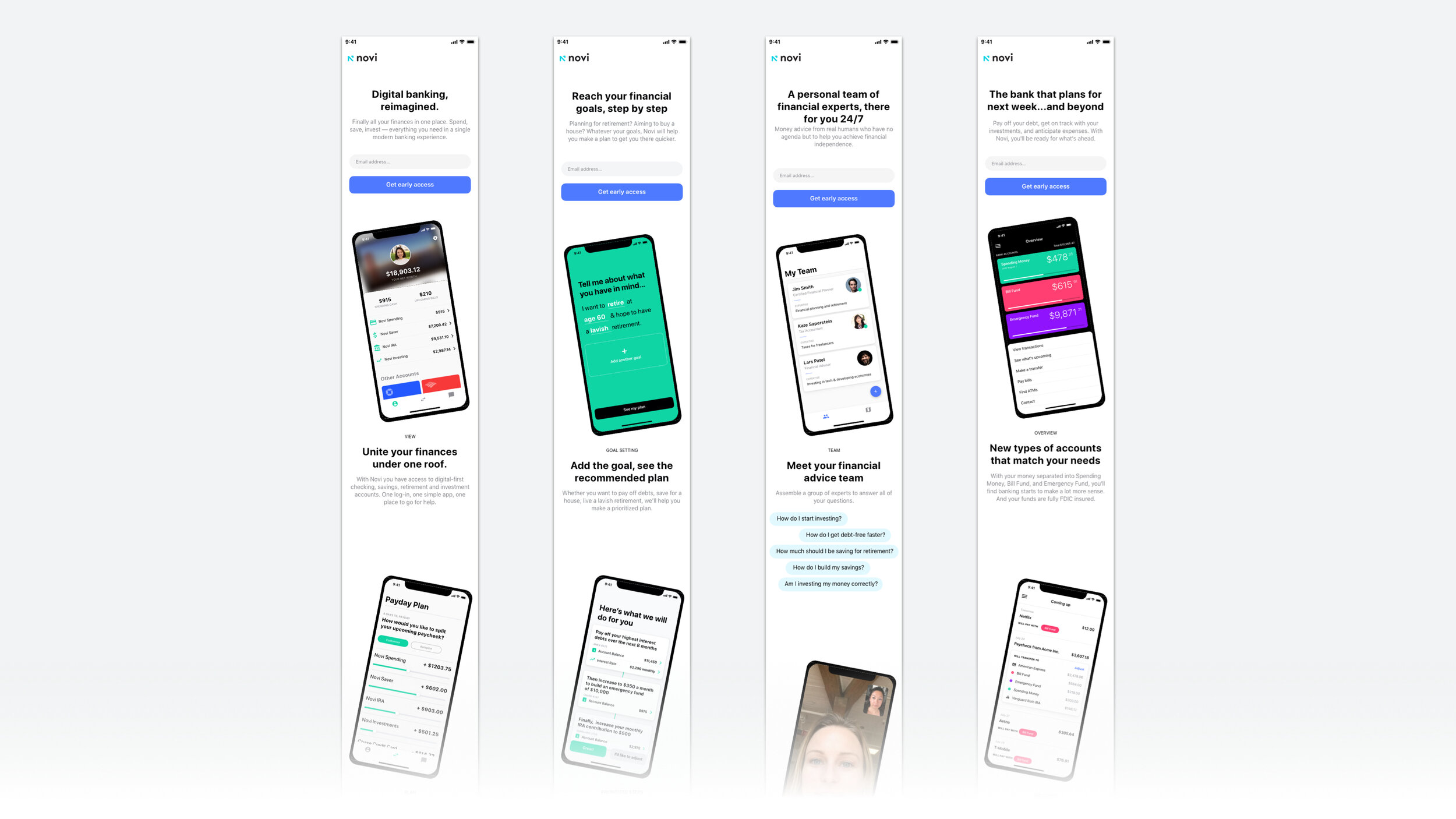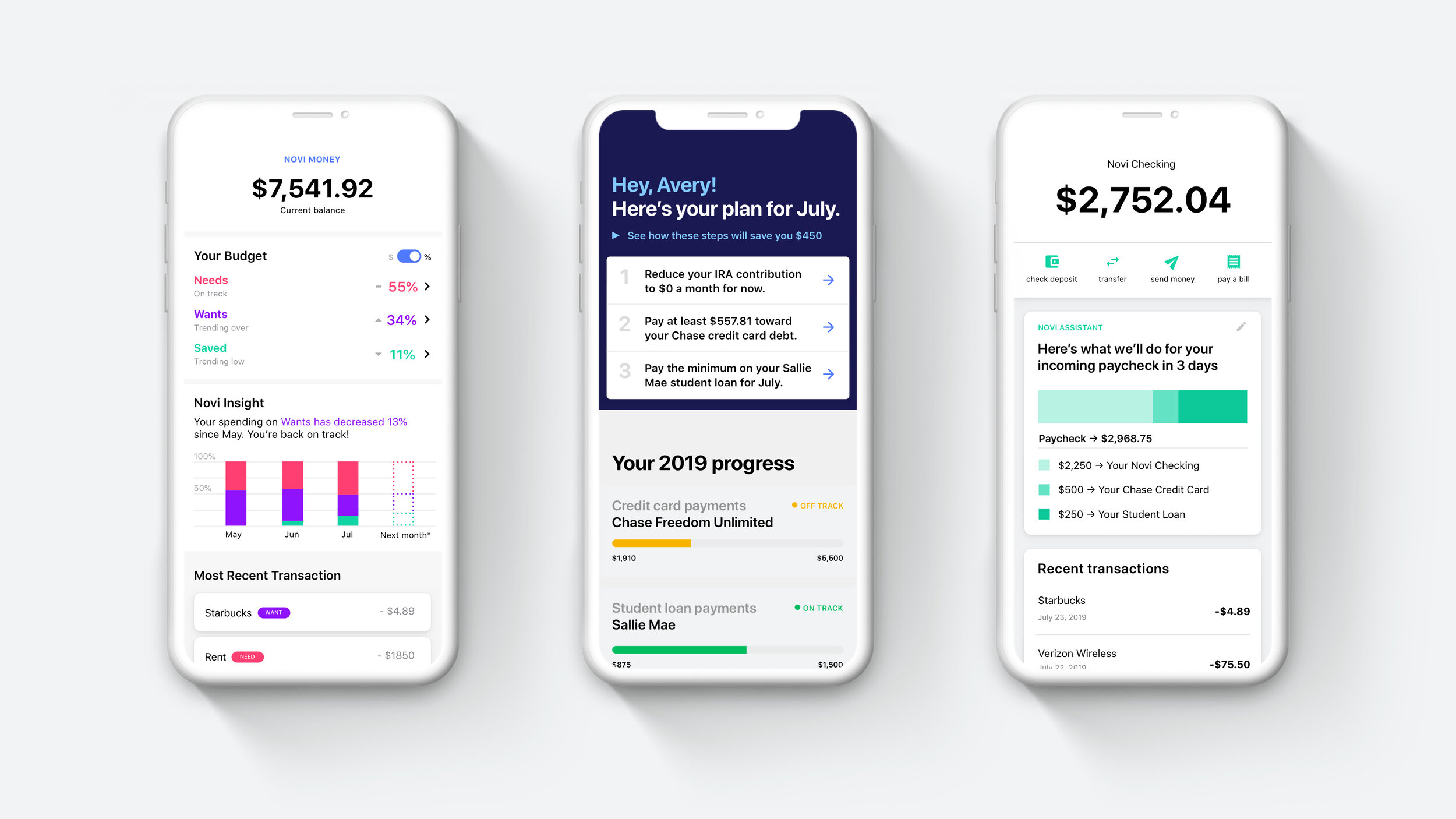Novi Finance - taking the friction out of making the right financial decisions to maximize financial well-being
USER RESEARCH, EXPERIENCE CONCEPTING, PRODUCT DESIGN
At Doberman, we partnered with Novi Finance to help create a revolutionary banking product that helps millennials get out of debt faster & make smarter financial choices.
The ask: Define the beta experience strategy & complete the initial design concept for the beta version of the app.
My role: Product design intern contributing to concept development based on pain points identified in user research, moderated 6 user interviews for concept validation, helped synthesize user testing insights for client share out & participated in 2 Design Sprints translating concepts into both low-fidelity & higher-fidelity InVision prototypes.
The team: 3 product designers, design director, business developer & project manager. I worked Phase 1 of this project, 6 weeks.
3 work in progress prototypes, tested with users for concept & feature validation
Immersion, inspiration & discovery of Novi’s origin story & the problem space
Week-long client kick off, downloading insights from Novi’s prior user research & target audience hypotheses as well a deep dive into their current tool.
Ideation of product value & differentiation from competitors.
We conducted 6 user interviews to further refine the client’s target audience hypothesis & help build our understanding of the wide spectrum user needs. I moderated 2 interviews.
Synthesizing interview insights to identify potential opportunities to explore in our upcoming experience concepting sessions.
Concepting potential value propositions for prototyping & user testing
Identify user groups/segments based on pain points discovered during our user interviews as well as Novi’s prior user research to aid our ideations of potential value propositions.
Create How Might We statements based on user research insights to drive our initial concept explorations.
Cluster ideas to identify themes for potential value propositions, defining the core experience principles & functionality hypothesis.
Prototype 4 distinct concepts as landing pages during Design Sprint 1, I prototyped one of these concepts targeting financial goal creation & step by step recommendations.
We conducted 6 user interviews to test our value props & feature sets. Landing page prototypes were used as conversation starters to provoke a response in testing. I moderated 2 of these interviews.
Portion of synthesis presentation, capturing themes in user reactions of the 4 landing pages
Interview Methodology: We interviewed 6 people of varying financial literacy at varying stages of their financial journey. The interviews were conducted using open question style interviews to dive deeper into user needs & test the value propositions in 4 landing page prototypes.
Rapid paper prototypes to quickly refine our concepts based on user testing insights
Based on user pain points & opportunities identified from the Design Sprint 1 synthesis, HMW statements helped us further explore potential features & Novi’s overall product offering during several sketching sessions.
A few areas of focus for our sketching: financial literacy, financial planning & recommendations, and financial health & awareness.
Presenting low-fidelity sketch paper prototypes to the client, 3 out of 5 concepts were selected as the focus for Design Sprint 2 & the next round of user testing.
Higher-fidelity prototypes based on user interview insights & paper prototyping
The team created 3 click-through InVision prototypes to illustrate our research hypotheses & varying value propositions. My design responsibility was executing 1 of the prototypes, the concept focused on increasing user’s financial awareness via 50/30/20 budgeting principal.
To further understand our target audiences financial needs & validate our hypotheses, 7 user interviews were conducted using open question style interview format. I moderated 4 interviews, getting a background into the user’s financial background & pain points as well as testing tasks within each of the 3 InVision prototypes.
Budgeting based concept I executed during Design Sprint 2
Synthesizing insights from testing as key takeways moving forward
Analyzing responses from our 7 user interviews, themes in feedback were identified for the 3 concepts individually as well as the overall key takeways from user testing as a whole.
A few key takeaways identified in testing included: user’s desire for balance in automation & personalization in financial planning, the user’s need to understand why the algorithm is recommending certain financial decisions, how prominent long-term planning vs. short-term actions & clarity in a user’s overall financial health.
Synthesizing insights from testing was presented to Novi, along with recommended research questions & areas of focus for Design Sprint 3.
Final thoughts & personal learnings
Due to resourcing, after 6 weeks I jumped off Phase 1 of the Novi project to support the TodayTix project.
Some of my biggest learnings during my time on the project concern user interviews & testing synthesis. A few of these learnings include:
Testing synthesis starts during interviews, incorporating as many as possible from the rest of the design team, or client side, to listen in via recording & participate in a live synthesis document to harness multiple perspectives of the interview immediately.
Live synthesis & notes from the interview make analyzing interviews during post interview synthesis more efficient.
Synthesising as a team maximizes learnings & insights, a democratic means of empathising with the user that the entire team takes with them into more thoughtful ideation & prototyping sessions.











